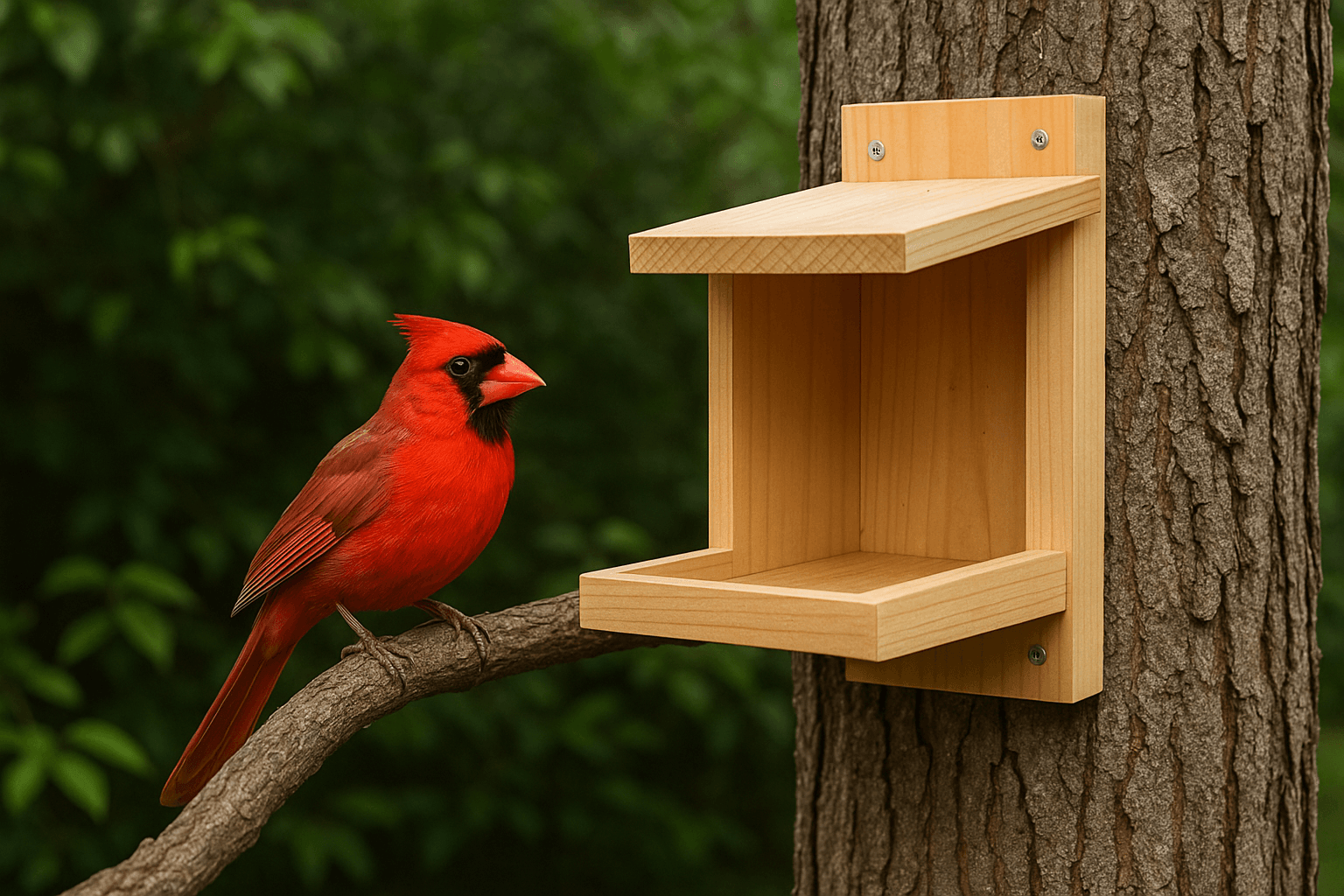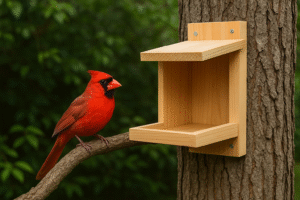Will Cardinals Use a Birdhouse? The Surprising Truth & How to Really Attract Them

It’s one of the most common questions I hear as a backyard birding consultant: “I bought a beautiful red birdhouse, but the cardinals won’t go near it. What am I doing wrong?” It’s a question born from a deep appreciation for this stunning bird. A flash of crimson against a snowy backdrop or the male’s cheerful song cutting through a summer morning is a true delight. We love cardinals so much that we want to roll out the red carpet for them, offering up a custom-built home.
I get it completely. For years, I had a special “cardinal-only” house near my feeders, waiting for a pair to move in. But after seasons of watching wrens and chickadees claim every other box in my yard, while the cardinals completely ignored my offering, I dove into the research and field observation. The answer I found was both simple and profound, and it changed my entire approach to attracting these beloved birds.
The Direct Answer
No, Northern Cardinals will not use a birdhouse or a nest box. Despite their popularity, cardinals are not cavity-nesters. They are part of a different class of birds that build intricate, open-cup nests in dense shrubs, thickets, and low trees. A birdhouse, which mimics a hole in a tree, is something they simply do not recognize as a suitable place to raise a family.
So, does this mean you can’t have the joy of watching a cardinal family in your yard? Absolutely not! It simply means you have to stop thinking like a real estate agent and start thinking like a landscape architect. This guide will walk you through the fascinating specifics of cardinal nesting behavior and then provide a detailed, actionable blueprint for turning your yard into a cardinal paradise—a place they will not only visit for food, but actively choose to call home.
Understanding the Cardinal’s Nest: A Masterpiece of Camouflage
To understand why a cardinal rejects a birdhouse, you have to appreciate the home they choose to build for themselves. Unlike a bluebird or a wren, who are cavity-nesters looking for a pre-made hole, cardinals are master weavers. The female cardinal is the primary architect, and her choice of location is driven by one thing: safety through concealment.
She seeks out a fork in the branches of a dense, leafy shrub or a low, thick tree, typically between 3 and 10 feet off the ground. Here, she builds her nest in four distinct layers:
- Outer Layer: A rough foundation of coarse twigs, grasses, and vine strips, often including bits of trash like plastic or cellophane for structure.
- Leaf Mat: A thick, insulating layer of dead leaves.
- Inner Cup: A beautifully woven cup of fine grapevine bark and rootlets.
- Lining: A soft, final layer of fine grasses, animal hair, and delicate stems to cushion the 1-5 pale, speckled eggs.
From My Field Journal: Last spring, I discovered a female cardinal building a nest in a dense dogwood shrub at the edge of my property. I watched from a distance for a week as she meticulously worked. She was a ghost, silently flying in with a twig or a strip of bark, disappearing into the leaves, and re-emerging empty-beaked moments later. The nest was so perfectly hidden that even knowing its location, I had trouble spotting it from 20 feet away. This is a level of security a birdhouse on a pole simply cannot offer a species like the cardinal.
This open-cup nest design is a completely different architectural philosophy from the birds that use our nest boxes. For them, the hard walls of a cavity are the security. For a cardinal, security is the dense maze of interlocking branches and leaves that surround their woven cup. Our guide on what birds use birdhouses dives deeper into the types of birds that *do* seek out cavities.
The Four Pillars of a Cardinal-Friendly Habitat
So, we’re throwing out the birdhouse. What’s the new plan? We’re going to create the perfect cardinal neighborhood right in your backyard. A yard that provides for all their needs is a yard where cardinals will not only feed, but will also pair up, nest, and raise their young. There are four essential pillars to this habitat.
Pillar 1: Provide Dense Cover & Nesting Sites
This is the most important and often overlooked step. If you have a perfectly manicured lawn with a few tall, thin trees, cardinals might visit your feeder, but they will never stay to nest. They need dense, shrubby cover—what ecologists call “thicket.”
The Best Plants for Cardinal Nesting:
- Dogwood (Cornus spp.): Shrubs like Red Twig or Gray Dogwood are perhaps the perfect cardinal nesting plant. They have dense, multi-stemmed growth with plenty of horizontal forks.
- Honeysuckle (Lonicera spp.): Both native vine and bush honeysuckles provide the dense tangle cardinals love.
- Hawthorn (Crataegus spp.): The dense branches and thorns offer fantastic protection from predators.
- Evergreens: Low, dense conifers like Arborvitae, Juniper, or Spruce provide crucial year-round cover and early-season nesting sites before deciduous trees leaf out.
- Grapevines (Vitis spp.): Wild grapevines create the ultimate tangle and also provide bark strips that cardinals use as a primary building material.
Plant these shrubs in groups or hedges along the edges of your property to create the feeling of a woodland edge. A cardinal feels most secure when it has a safe, shrubby highway to travel along, rather than having to fly across a wide-open lawn.

Start with the Perfect Nesting Shrub: Red Twig Dogwood
If you plant one thing to attract nesting cardinals, make it a dogwood shrub. This live Red Twig Dogwood from Daylily Nursery is a perfect choice. It arrives ready to plant and will grow quickly into a multi-stemmed, dense shrub that provides the ideal structure for a cardinal nest. Its four-season interest, with white flowers in spring, berries in summer, and brilliant red stems in winter, makes it a beautiful addition to any landscape. Planting a few of these is like putting up a “vacancy” sign for cardinals.
Check Price on AmazonPillar 2: Offer Their Favorite Foods
While cover is what will convince them to nest, food is what will bring them to your yard in the first place. Cardinals are primarily seed-eaters, and their large, powerful beaks are perfectly designed for cracking tough shells.
The Best Feeder for Cardinals:
Cardinals are larger songbirds and can be clumsy on small perches. They much prefer a stable, flat surface to land on. This is why **platform feeders or hopper feeders with a large tray** are far more effective than small tube feeders. They allow the cardinal to land comfortably and face its food directly.

The Ideal Cardinal Feeder: Droll Yankees Platform Feeder
This platform feeder is a cardinal magnet. The open tray design gives them plenty of space to land and feed without awkward perching. The roof provides protection from rain and snow, keeping the seed dry. Crucially, the mesh floor allows for excellent drainage, which prevents seed from molding and causing disease. It’s made from durable, recycled plastic that won’t rot or fade. I’ve found that cardinals will choose a feeder like this over a standard tube feeder every single time. It’s an essential piece of hardware for any cardinal enthusiast.
Check Price on AmazonThe Best Seeds for Cardinals:
You can offer the fanciest mix, but cardinals have two clear favorites. Our complete guide to the best bird seed has more detail, but for cardinals, focus on these:
- Black Oil Sunflower Seeds: This is the universal favorite. The high oil content provides excellent energy, and the thin shell is easy for them to crack.
- Safflower Seeds: This is the “magic” seed. Cardinals love it, but most squirrels, grackles, and starlings—the common feeder bullies—hate it. If you’re having trouble with pests, switching to 100% safflower is a game-changer.
Pillar 3: Provide a Consistent Water Source
Water is just as important as food. Cardinals need to drink daily, and they also need to bathe to keep their feathers in top condition for flight and insulation. A reliable birdbath can be a major attraction.
Choose a shallow basin (1-2 inches deep) with a rough texture for good footing. Place it about 10-15 feet away from dense cover, so the cardinals can see predators coming but have a quick escape route to their safe space. Keeping the water clean and, if possible, moving with a dripper or water wiggler, will make it even more irresistible.
Pillar 4: Ensure a Safe Environment
A cardinal pair will not choose to nest in a yard where they feel constantly threatened. This means creating a peaceful and secure territory.
- Keep Cats Indoors: Domestic cats are a leading cause of songbird mortality. A yard with a roaming cat will never be a safe nesting site.
- Avoid Pesticides: Cardinals feed their young a diet of insects. Using pesticides on your lawn and garden eliminates this vital food source and can poison the birds.
- Provide Space: Don’t place your feeders and birdbaths right next to their likely nesting shrubs. Give them a buffer zone so they can raise their family in peace.
Frequently Asked Questions (FAQ)
I saw a cardinal pecking at a birdhouse. What was it doing?
This is a common observation! Cardinals are curious birds. They might land on a birdhouse to investigate it, look for insects or spiders on the surface, or even see their own reflection in the entrance hole, which they might perceive as a rival. They are not, however, considering it as a nesting site.
Are there any “nesting shelves” or special structures cardinals will use?
Some people have had limited success with nesting shelves, which are open-sided platforms. A robin or a phoebe is more likely to use one of these than a cardinal. While it’s a slight possibility, you will have infinitely more success by simply planting a dense dogwood or honeysuckle shrub. It’s always best to mimic their natural preference.
How can I tell if cardinals are nesting in my yard?
Look for behavioral clues during the spring and summer. A pair will become very territorial, chasing other cardinals away. You’ll see the female, not the male, doing most of the nest building. The biggest clue is seeing the parents carrying insects (caterpillars are a favorite) in their beaks. Since they primarily eat seeds, carrying soft insects is a sure sign they have hungry nestlings to feed nearby.
Do cardinals use birdhouses for shelter in the winter?
No. While many cavity-nesting birds like bluebirds and chickadees will use birdhouses to roost in during cold nights, cardinals will not. They prefer to shelter deep inside dense evergreen trees or shrubs, like spruce or arborvitae, which provide excellent protection from wind and snow. This is another reason why planting evergreens is so beneficial.
Conclusion: A Paradise Built on Understanding
The secret to attracting nesting cardinals has nothing to do with buying the right birdhouse and everything to do with cultivating the right habitat. It requires a shift in perspective—from providing a human-made structure to curating a natural, safe, and resource-rich environment. By planting dense thickets for cover, offering their favorite foods in the right feeders, providing clean water, and ensuring their safety, you are speaking their language. You are creating a cardinal paradise.
Forget the bright red birdhouse. Your reward will be something far greater: the thrill of discovering a meticulously woven nest hidden in the leaves, the joy of watching parents diligently feed their hungry young, and the satisfaction of knowing you’ve created a true home, built on nature’s own terms.

